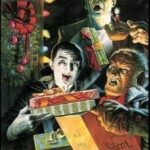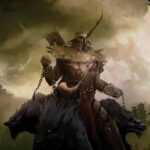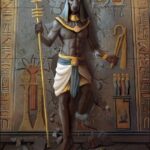Typical Halloween costumes have traditionally been monsters such as vampires, ghosts, witches, and devils.
In recent years, it has become common for costumes to be based on themes other than traditional horror, such as dressing up as a character from a TV show or movie, or choosing a recognizable face from the public sphere, such as a politician (in 2004, for example, George W. Bush and John F. Kerry were both popular costumes in America). In 2001, after the September 11 attacks, for example, costumes of Islamic terrorists, firefighters, police officers, and United States military personnel became popular among children and adults. In 2004, an estimated 2.15 million children in the United States were expected to dress up as Spider-Man, the year’s most popular costume.
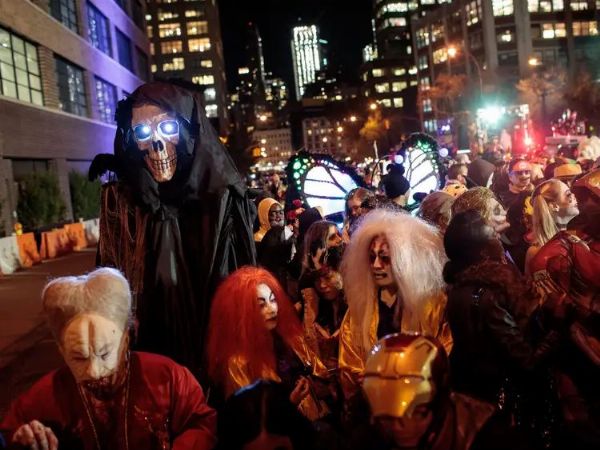
Although popular histories of Halloween claim that the practice goes back to ancient celebrations of Samhain, in fact there is little primary documentation of masking or costuming on Halloween before the twentieth century. Wearing masks and other disguises and blackening the face with soot were originally ways of hiding oneself from the spirits of the dead who might be roaming around. This is the origin of Halloween masquerading as devils, imps, ogres, and other demonic creatures.
Costuming became popular for Halloween parties in America in the early 1900s, as often for adults as for children. The first mass-produced Halloween costumes appeared in stores in the 1950s when trick-or-treating became a fixture throughout the United States.
The late 2010s saw a wave of schools outright banning Halloween costumes and celebrations from school grounds, sometimes opting for “harvest” celebrations instead. The most frequent reasons for the bans were safety, the fear of scaring children, or general exclusivity. Clowns costumes have also been banned because of a evil clowns sightings craze wave across America that occurred in 2016.
The conversation around Halloween has shifted in recent years to costumes that did not offend. Schools have instituted guidelines and warnings to students, while criticism from some social commenters claims the holiday has become too political.
Homemade costumes have seen a recent resurgence in popularity, likely thanks to the growth of Pinterest, Ravelry, and niche communities centered around crafting. Social media and popular parenting blogs may also be a contributing factor.
What sets Halloween costumes apart from costumes for other celebrations or days of dressing up is that they are often designed to imitate supernatural and scary beings. Popular monsters of legend or fiction are regular themes for Halloween costumes, as are pop culture figures like presidents, or film, television, and cartoon characters. Another popular trend is for women (and in some cases, men) to use Halloween as an excuse to wear particularly revealing costumes, showing off more skin than would be socially acceptable otherwise.
Halloween costume parties generally fall on, or around, October 31, often falling on the Friday or Saturday prior to Halloween.
Economics and behavior
In America, spending on Halloween costumes is expected to reach $3.1 billion, with 67 percent of Halloween celebrants planning to purchase costumes this year.
More than three million children will dress as their favorite action or superhero, 2.9 million will dress as their favorite princess and 2.5 million plan to dress as a cat, dog, bunny or other animal.
More people are buying costumes for their pets. Americans spent $490 million on costumes for their pets in 2019—more than double what they spent in 2010.
Children’s Costumes
- Action/Superhero
- Princess
- Animal (Cat, Dog, Lion, Monkey, etc.)
- Batman Character
- Star Wars Character
- Tie: Witch AND DC Superhero (excl. Batman)
- Frozen Character (Anna, Elsa, Olaf)
- Marvel Superhero (excl. Spiderman)
- Zombie
- Spiderman
As millennials plan for their party attire for Halloween weekend, more than nine percent will reach for a Batman costume, followed by 6.1 percent opting for witch hats and brooms and five percent planning to dress as an animal.
Adults 18-34-years-old
- Batman Character (Batman, Harley Quinn, The Joker, etc.)
- Witch
- Animal (Cat, Dog, Bunny, etc.)
- Tie: Marvel Superhero (Deadpool, Spiderman, etc.) AND DC Superhero (Wonder Woman, Superman, excl. Batman)
- Vampire
- Video Game Character
- Slasher Movie Villain (Freddy, Jason, Michael Myers, etc.)
- Pirate
- Star Wars Character
- Zombie
Halloween isn’t just a holiday for kids and young adults, and this year plenty of adults will be getting in on the action. More than 76 percent of adults have already decided what to dress as this Halloween. While most adults will don a witch or pirate costume, with no surprise, more than four percent of older adults will turn to current events like the presidential election for their costume inspiration.
Adults 35+
- Witch
- Pirate
- Political (Trump, Clinton, etc.)
- Vampire
- Batman Character (Batman, Catwoman, etc.)
- Animal (Cat, Dog, Bunny, etc.)
- Tie: DC Superhero (Superman, Wonder Woman, excl. Batman) and Star Wars Character
- Tie: Ghost and Zombie
- Scary Costume/Mask
- Marvel Superhero (Iron Man, Hulk, Spiderman, etc.)
Pets
Many families want the whole house dressed up on Halloween, including their pets. Sixteen percent of consumers plan to dress their pets in costume in 2021 and 86.7 percent of those consumers already have a plan for their pet’s costumes. Pumpkin, hot dog and bumble bee are at the top of the list again this year.
The most popular pet Halloween costumes in 2022 are as follows:
- Pumpkin
- Hot Dog
- Bumble Bee
- Tie: Lion and Star Wars Character
- Devil
- Batman Character
- Witch
- Superman
- Action/Superhero
- Cat
The survey asked 6,791 consumers about Halloween costume plans. It was conducted September 6-13 and has a margin of error of plus or minus 1.2 percentage points.
Source: NRF’s 2016 Halloween Consumer Top Costumes Survey conducted by Prosper Insights & Analytics.
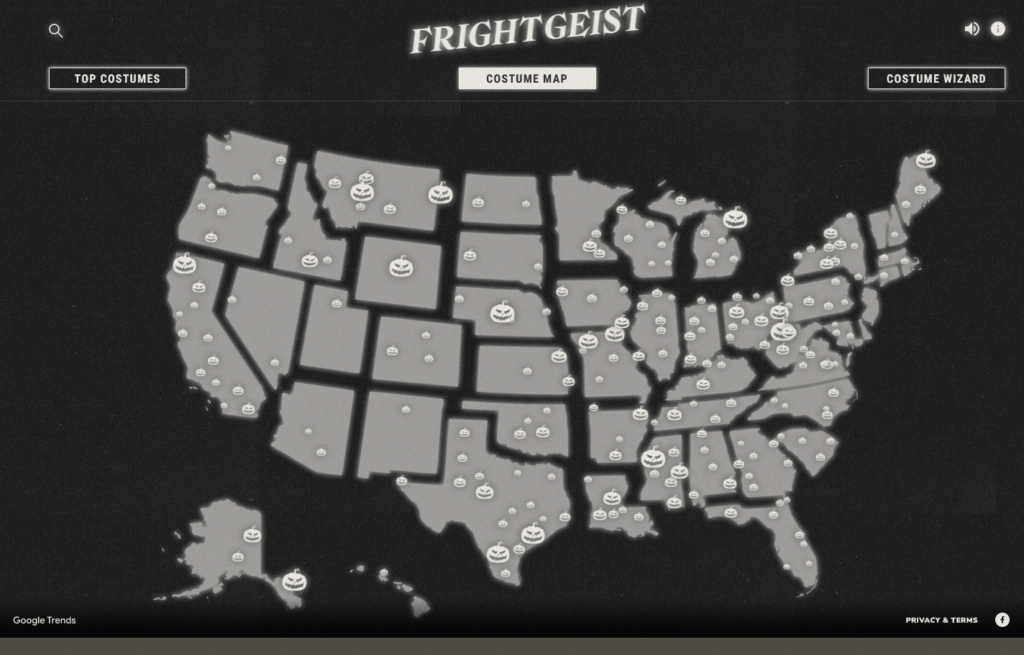
Seeking inspiration for your Halloween costume or theme for this year?
Google has updated its ‘Frightgeist’ trends site, which outlines key costume trends, based on search volume, from across the US.
Google’s also includes a costume wizard, which recommends costume ideas based on your region, desired style (‘classic’ or ‘modern’), as well as ‘uniqueness’ and ‘spookiness’ level.



